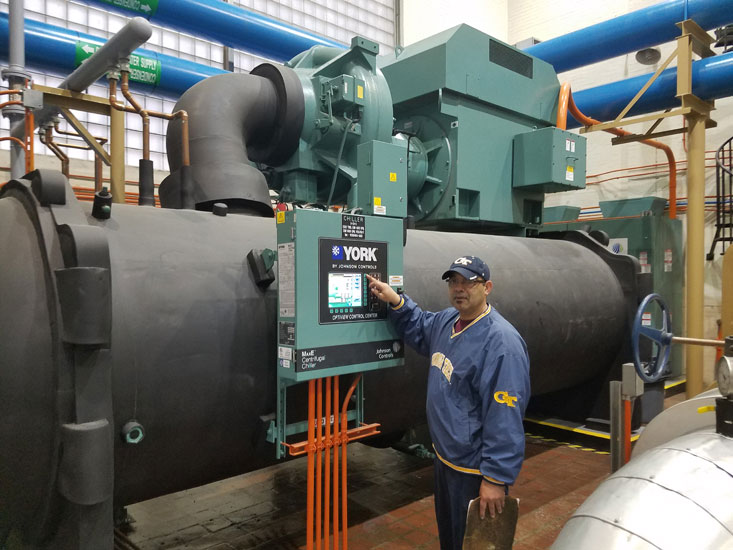Refrigeration Cycle:
The refrigeration cycle, a thermodynamic mechanism that permits the transfer of heat from one location to another, is the central component of every chiller system. There are four primary parts to this cycle: the evaporator, expansion valve, compressor, and condenser. Low-pressure, low-temperature refrigerant vapor is compressed by the compressor to increase its pressure and temperature at the start of the process. After entering the condenser, the high-pressure vapor releases heat into the surrounding air and condenses into a liquid. After passing through the expansion valve, where its pressure decreases and the liquid refrigerant evaporates, heat from the chilled water loop in the evaporator is absorbed. At last, the cycle is repeated with the low-pressure vapor going back to the compressor.
Compressor:
An essential component in chiller systems, the compressor is the engine of the refrigeration cycle. Its main purpose is to increase the refrigerant vapor’s temperature and pressure to facilitate effective heat transfer. There are several varieties of compressors, each with specific features and uses, including screw, scroll, reciprocating, and centrifugal. Smaller chillers often employ reciprocating compressors, but bigger systems use centrifugal compressors because of their superior capacity and efficiency. The proper compressor type should be chosen based on several criteria, including space constraints, energy efficiency needs, and cooling demand.
Condenser:
The condenser is where hot refrigerant vapor is turned into a liquid and acts as the chiller system’s heat rejection component. Via air-cooled or water-cooled condensers, heat from the refrigerant is transferred to a cooling medium, usually air or water. The refrigerant is condensed and heat is dissipated in air-cooled condensers by blowing ambient air over finned coils. Contrarily, water is used as the cooling medium in water-cooled condensers, which circulate water through tubes to absorb refrigerant heat. The decision between water-cooled and air-cooled condensers is influenced by several variables, including available water, available space, and ambient temperature.
Evaporator:
The chiller system’s heat-absorbing element, the evaporator is where liquid refrigerant absorbs heat from the process fluid or chilled water loop and causes it to evaporate. The chilled water or process fluid passing through the evaporator coils cools as the refrigerant evaporates. After being chilled, the fluid is pushed to the required spot, where it picks up heat before returning to the evaporator to finish the cycle. A variety of layouts, such as shell-and-tube, plate-and-frame, and coil-in-tank designs, are available for evaporators; these designs are customized to meet particular application needs, such as capacity, efficiency, and space limitations.
Expansion Valve:
This device controls the temperature and pressure of refrigerant as it enters the evaporator coils by managing the flow of refrigerant into the evaporator. Through the regulation of refrigerant flow, the expansion valve guarantees the chiller system’s optimal performance, upholding steady evaporator conditions and optimizing efficiency. Thermostatic expansion valves (TXVs) and electronic expansion valves (EEVs) are two popular varieties of expansion valves that provide accurate control over refrigerant flow depending on variables like evaporator load and environmental circumstances. The expansion valve must be chosen and sized properly to guarantee effective chiller operation and avoid problems like inadequate cooling capacity.
Control System:
To guarantee peak performance, energy economy, and dependability in contemporary chiller systems, complex control systems are essential. These systems modify operating conditions to match load demands and environmental circumstances by monitoring multiple parameters, including compressor capacity, refrigerant pressure, and chilled water temperature. Precise adjustment of the compressor speed, condenser water flow, and evaporator temperature is made possible by advanced control algorithms, which maximize system efficiency and reduce energy usage. Furthermore, central monitoring and control of several chillers is made possible by integration with building automation systems (BAS), which maximizes occupant comfort and overall building energy management.
Protections & Safety Devices:
Chiller systems must have safety mechanisms and protections in place to protect workers, the environment, and equipment from potential dangers and malfunctions. These gadgets include, among other things, temperature sensors, oil level monitors, high and low-pressure switches, and pressure relief valves. Pressure relief valves guard against overpressurization of parts like the evaporator and condenser, and high- and low-pressure switches cut the system off in the event of unusual operating circumstances. Temperature sensors allow for the early identification of freezing or overheating conditions, which sets off alarms and initiates safety measures. By ensuring that compressor parts are properly lubricated, oil level monitors help to avoid damage and downtime. To guarantee the safe and dependable functioning of chiller systems, routine maintenance, and testing of safety components are essential.
How Long Does Aircon Last?
An air conditioner’s normal lifespan is between 10 and 15 years, however, several factors might affect this. The caliber of care and maintenance it receives is one important component. An air conditioner’s lifespan can be greatly increased with routine maintenance, which includes checking and cleaning coils, replacing or cleaning filters, and making sure there is enough airflow. Environmental factors also come into play; equipment functioning in challenging circumstances with high humidity or temperatures may not last as long.
The frequency of use is still another crucial factor. More frequent use, particularly in warmer climates or year-round, may cause wear and tear on the unit and reduce its lifespan. An air conditioner’s lifespan might also be impacted by the caliber of installation. Optimized performance and a lower chance of premature failure are ensured by expert installation.
Purchasing an air conditioner of superior quality from a reliable manufacturer might also extend its lifespan. These devices frequently have warranties and are made to resist the stresses of frequent use. In the end, the best ways to extend the life of an air conditioner are through routine maintenance, correct installation, and selecting a high-quality unit.

